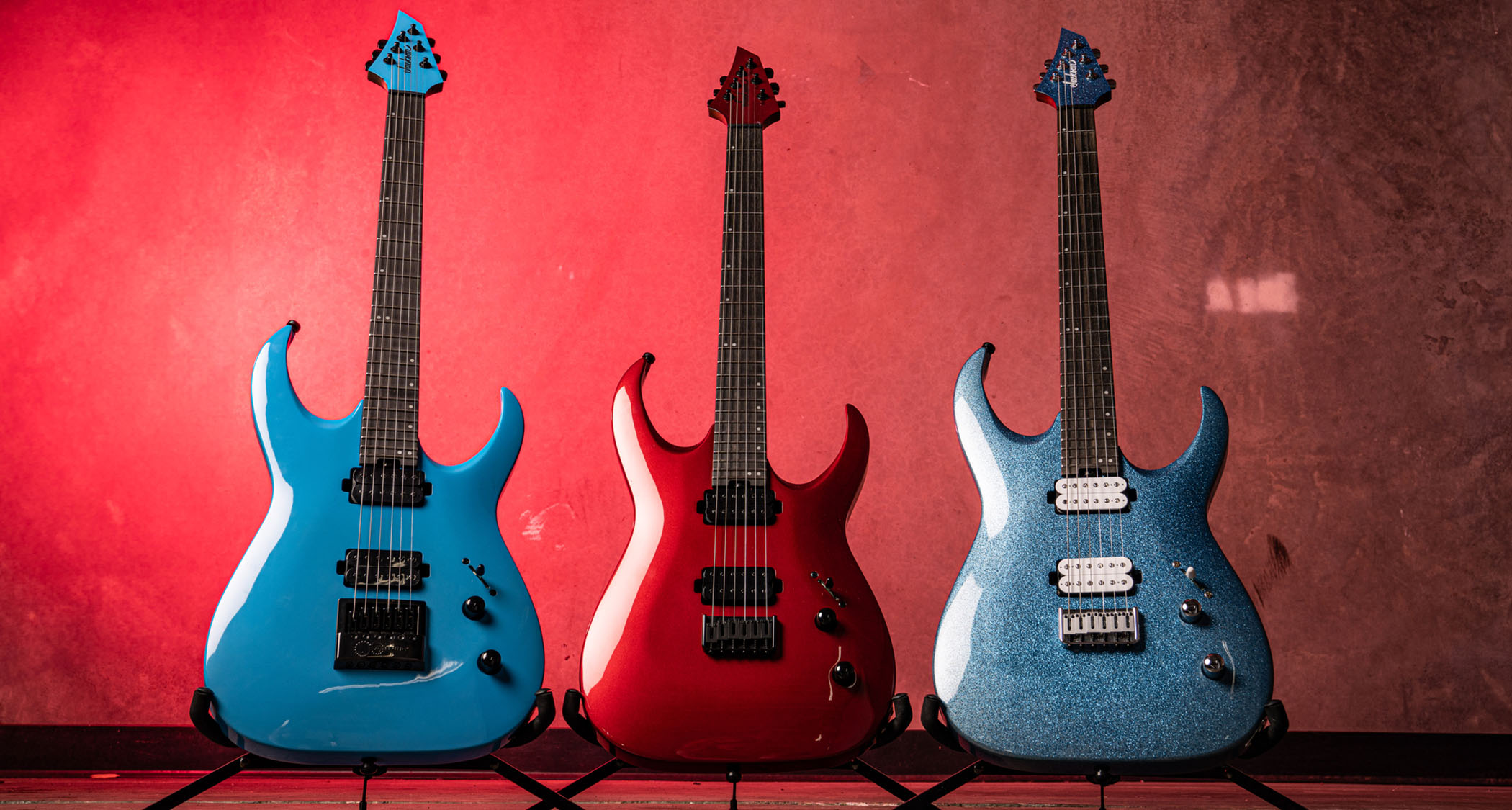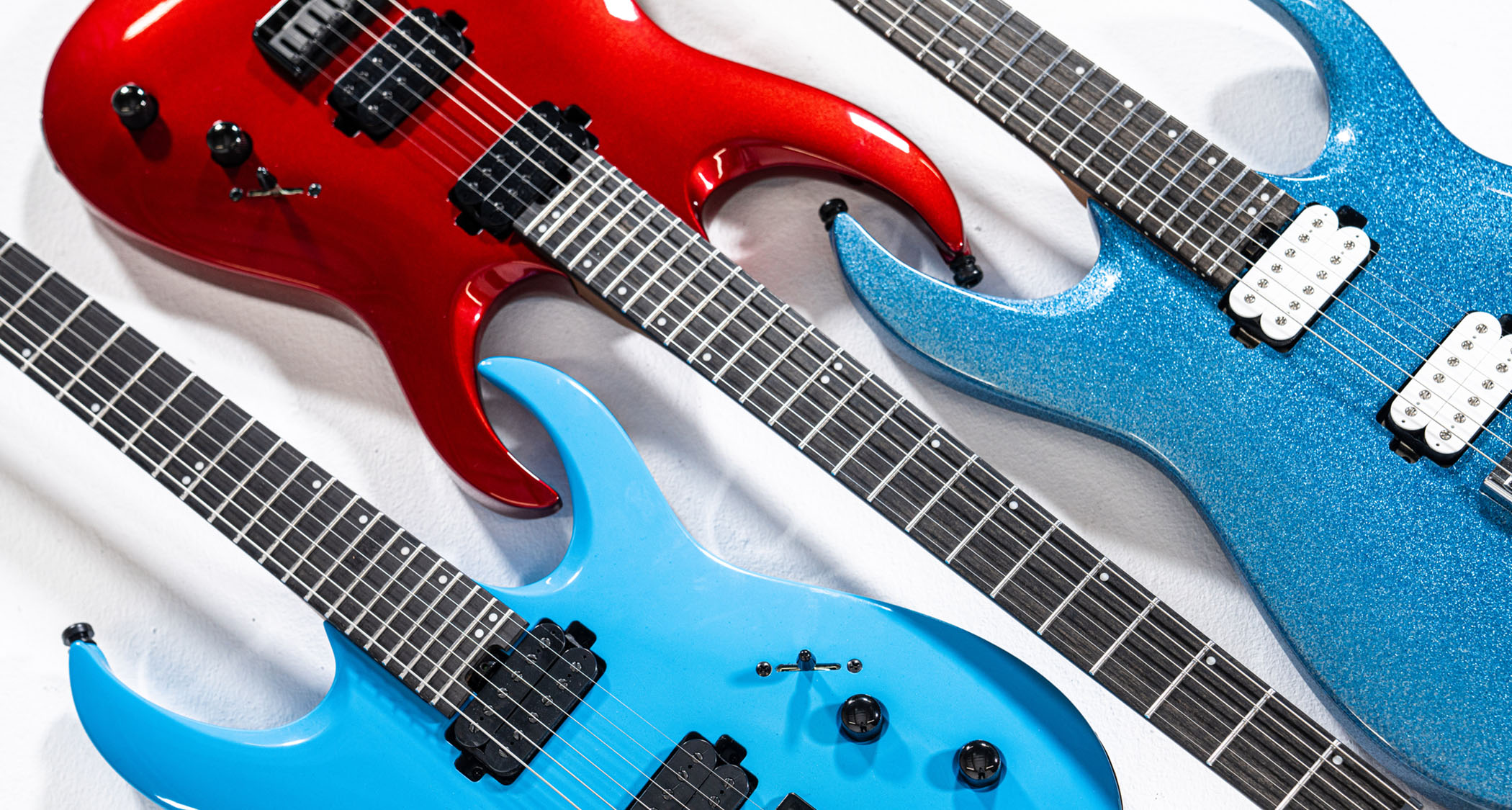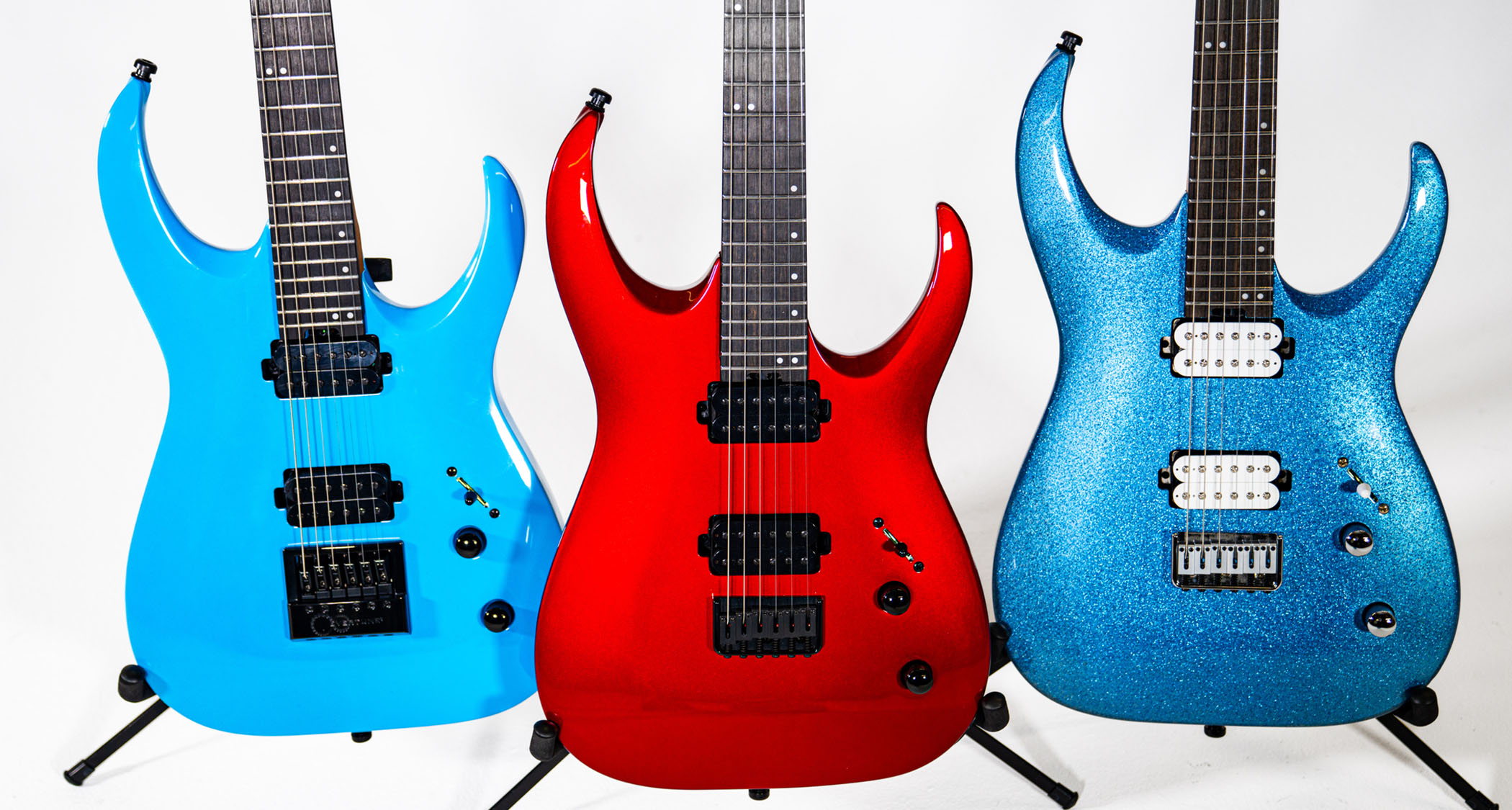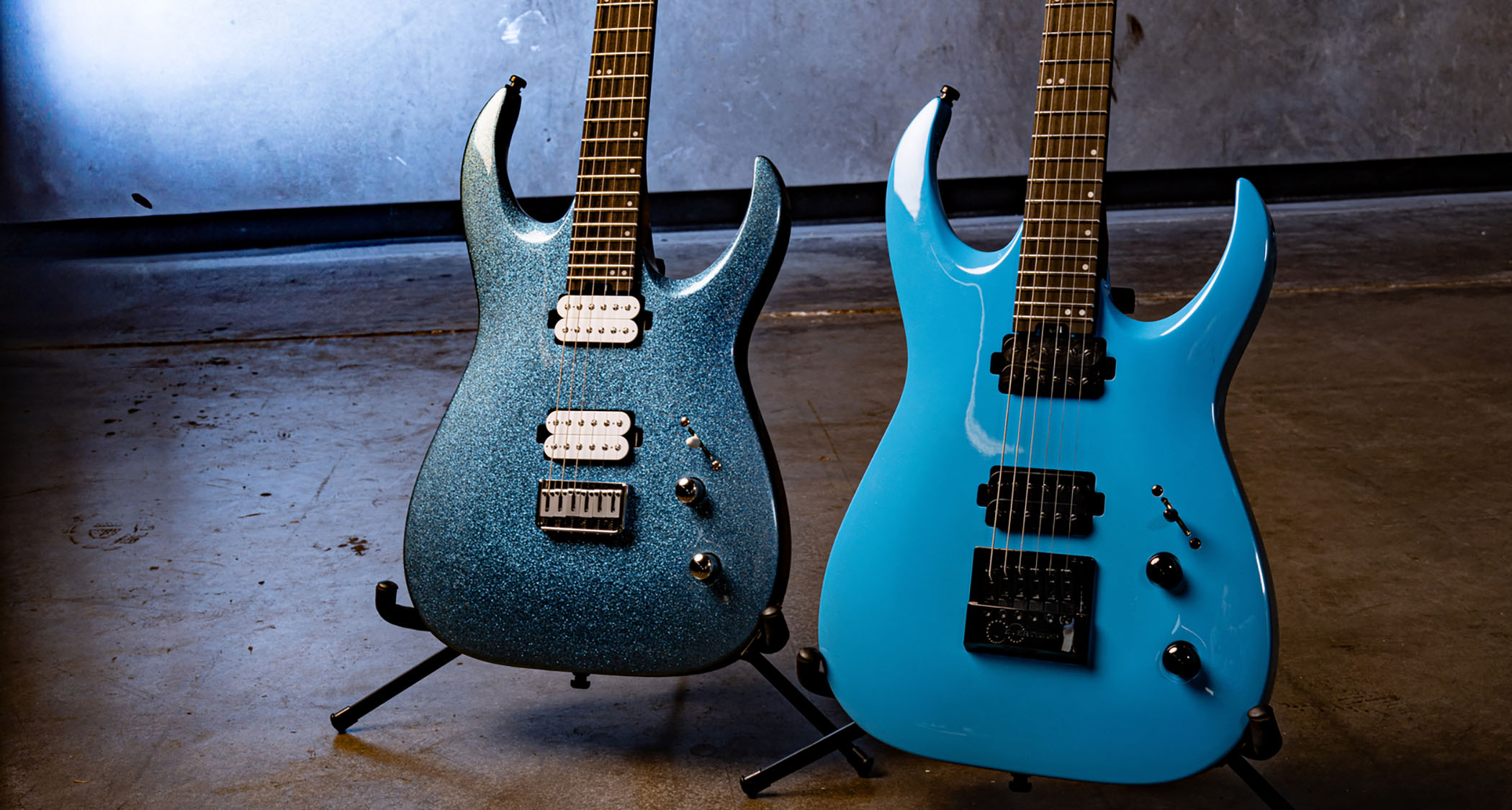“Use as a little gain as you can to get the idea across, which may still be all the gain in the world”: Periphery’s Misha Mansoor on exploring “absurd” tunings, his friends' genius, and why he is looking for someone to teach him guitar
We catch up with the Periphery riff-master to discuss his refreshed Jackson Juggernaut, custom offsets, collabs with Mike Dawes, and why – vintage or modern – good gear is good gear

Whether he likes it or not, Misha Mansoor is one of those players who has modernised metal guitar for the 21st-century. “That’s a lot of responsibility to put on me!” he protests. But it happens to be true.
He and his fellow Periphery guitarists, Jake Bowen and Mark Holcomb, have been at the vanguard of contemporary progressive metal, augmenting the art-form, twisting it around new rhythms, recontextualising electric guitar tone for the digital era and taking it into the realms of a quasi-genre that people call djent.
It doesn’t matter where you stand on that term, whether djent is a genre or not – and the Periphery catalogue has it both ways on that matter – we all know what it sounds like.
With Periphery, Mansoor pursues ever more esoteric tunings, seeking out extended-range instruments to muscle in on the bass guitar’s fiefdom. In sum, three guitars operating like this can overwhelm an audience just with the sheer amount of guitar. But all that requires some careful sound engineering – it needs to be tight, locked-down.
It’s one of the reasons why you’ll find an EverTune bridge on Mansoor’s state-of-the-art signature guitars from Jackson – the Juggernaut – which has just been refreshed in Riviera Blue, and is offered with a six-saddle hard-tail in Blue Sparkle and Red Crystal. This tricked-out high-performance guitar is one of the reasons for our Zoom call.

As a feat of engineering, the EverTune is up there with the Floyd Rose double-locking vibrato, and while it might not exert such a radical influence upon the sounds we hear from our guitars, it might well yet become every bit as ubiquitous.
“We have been using EverTunes in the studio ever since Juggernaut,” he says. “The last 10 years or so. To be entirely honest, there is slight feel and tone tax that you pay with an EverTune bridge – not unlike a Floyd Rose. At the end of the day, a good hardtail bridge is going to sound the best.
Want all the hottest music and gear news, reviews, deals, features and more, direct to your inbox? Sign up here.
“It is [about] picking the right guitar for the part. If you feel like it’s more important for that part to be really in tune, we can reach for the EverTune. If the tuning stability doesn’t matter quite as much and we want the tone, we go for the regular bridge in the studio. Sometimes we do both and A/B them to see if one sounds better than the other.”

This compare and contrast ethos feels very much a part of Mansoor’s process, particularly in his search for tone. In recent months we have seen him with these Custom Shop baritone offset guitars from Jackson. He has an eight-string Juggernaut with an EverTune. Are we going to see these enter production?
“Oh! We are not supposed to know about that or talk about that!" he says. “No comment! [Laughs] That was the only thing I didn’t have, an EverTune eight-string. It’s just a very useful tool to have. I have a Custom Shop one that I use live. It allows me to dig into the guitar a bit more... It does allow me to have a little more fun onstage.”
Well, Mansoor is coy on that stuff but more forthcoming here about what he looks for in a guitar – in any piece of gear – about how friend and sometime Periphery collaborator Mike Dawes blows his mind with an acoustic guitar, and why, like the best of us, Mansoor is totally disgruntled with his guitar playing.
These baritone offsets you have been playing, they take influence from a more vintage perspective, and that’s not unusual for you. Talk to us about this tension between vintage and modern.
I have so many friends who play vastly different styles of music, and have vastly different playing styles, and yet we’ll converge on the same guitar and be like, ‘This is phenomenal!’
“I just like guitars. I think that’s all it is. I am a a student of guitar and I love the gear, and I love all gear that’s good. One of the lessons I have learned a little later in life – which is kind of an interesting lesson to learn – is that good gear is good.
“I know that’s a bit trite, but what I mean is I have so many friends who play vastly different styles of music, and have vastly different playing styles, and yet we’ll converge on the same guitar and be like, ‘This is phenomenal!’
“A good piece of gear is transparent like that. It allows you to be you and it doesn’t get in the way. Someone like me could take something that is more classic in design or whatever, but I can still extract my sound, or my version of my sound from it, and that’s fun because then it becomes this interesting facet of my sound, right? It’s not quite what I’d go for; it becomes its own thing, and then it evolves further.

How did you get turned on to these baritones in particular?
“This all started with me getting a Bass VI. I saw loads of people playing baritones and I saw people doing cool stuff Bass VIs, and I thought, ‘I wanna get a Bass VI. Let me play around with that.’ And then I was like, ‘This is such a cool instrument. I wonder what this would be like with humbuckers and my sort of setup. We ended up with my Custom Shop baritones, but it was really more the answer to a question. There was nothing quite like it out there.
“Like, if there was something out there that I could buy, I probably would have bought it, but there isn’t, so I had it made. Now they are turning out to be these really inspirational instruments. I am messing with this tuning, which is absurd on it, which you can only kind of get away with on a 30” scale.
What is this tuning? You have to reveal it!
“[Laughs] The tuning I’m messing with right now is Bb. We have this tuning that we use for this song called Reptile, and some other stuff on a six string, which is GGCFAD. So it’s Drop C, but the low string is dropped to a G, so you get an octave relationship between the lowest two strings. If you were to drop that whole tuning down to where the lowest string is a Bb, that’s the tuning that we’re using.
“It’s actually so low that we end up doing unison on the bass in Bb. It’s like low, low Bb. It’s barely audible! But you’ve got the octave there to sort of make it audible. It’s a really wild, weird tuning, and something that low would just not work if you didn’t have a 30” scale.
“But the rest of the strings still have got your typical six-string relationship and that means your moves and your left-hand muscle memory generally works. Also it’s a tuning relationship that I am fairly familiar with. It has just been pretty inspiring to play around with that.”
Does that require a radical change in your gear. I mean, do you start thinking bass speakers for frequencies that low?
“No, no we wouldn’t use bass cabs but at the end of the day it is about the relationship of the instruments, where they occupy the mix, right? So the bass is in the centre and you want it to actually occupy these low frequencies, and on the side, even if it’s unison, it is much more of a midrange instrument than doing a lot more top end. It is filling out complementary parts of the spectrum rather than infringing upon them.
That leads nicely to the next question. With three guitars, do you get away with using less gain, that there’s a summative effect from three guitars in the mix?
“This gain thing, I’m going to give a very unsatisfying response. Just use the right amount! I feel like people focus a lot on this. There are some people that are obsessed with using as little gain as possible, and some people that use way too much gain, and there are certain circumstances where using as little gain as possible is like exactly how you get the sound you want. Sometimes using way too much gain is the correct approach as well. So we do all all of the above, generally speaking.”

“I used to be much more in the let’s use a lot less gain category but you miss out on wonderful, wonderful saturation when you do that, and I love me some saturation! Especially with palm-mutes. If you want to bloom and purr, you need a good amount of gain, so I probably use more gain than people would realise but you want to be under control.
“It has just got to be that sweet spot where you have it under control, but you’re getting that good bloom from the low mids, and you really dial this in per guitar and maybe even per section. It has just got to be right for the part. Maybe a way of looking at it is use as a little gain as you can to get the idea across, which may still be, like, all the gain in the world! [Laughs]”

It is interesting that we are seeing more classically voiced pickups – e.g. Nolly’s Polypaf humbuckers – being fitted to high-performance modern guitars.
“I think this really reconciles nicely with what I was saying earlier. Good is just good. I remember trying the Bare Knuckle Mule set, which is their PAF replica, very low output, and you might think, ‘Why would you ever put this in a metal guitar?’ And I put it in something and if I dialled in my tone, maybe with a bit more gain, it sounded phenomenal!
The PAF is a very good pickup. It’s like this arbitrary design that just informed what guitar sounds like, therefore it sounds correct to me
“Good gear will work, especially if you know how to get your sound. And the PAF is a very good pickup. It’s like this arbitrary design that just informed what guitar sounds like, therefore it sounds correct to me, you know? So it makes sense that it would work, and I see what you’re saying, like, ‘Oh, in 60 years, surely we’ve invented some stuff that has revolutionised the way that we can move move tones forward.’
“In some ways, yes, [we have] but in some ways these are such small iterations and they are just choices and directions, that if you know how to shape your tone, you could get it out of almost anything so long as it’s good. It it’s bad gear, then you are fighting it, right?”
A post shared by Misha Mansoor (@mishaperiphery)
A photo posted by on
“But good gear, it kind of doesn’t matter if it is vintage or modern, and this has been my experience where you can you can extract [tone] out of anything and then sometimes it’s kind of fun to see what you can get out of like something that isn’t your comfort setup or something that you’d normally go for.
“You end up with some really interesting results because it is a slightly different version of your sound, but it doesn’t sound so alien that you couldn’t use it.”
Here’s a philosophical question about technicality. There are lots of virtuoso guitarists. But do you think that they – guitar players in particular – struggle to deconstruct that ability, to play simple stuff, or maybe even sloppy stuff if the song needs it? That we have a tendency to play to our limits?
I can play faster and more technical than I do with Periphery, but I don’t care to do it, doesn’t really do anything for me
“I disagree. My good friend Mike Stringer, he’s in Spiritbox. That dude can absolutely shred. He’s a phenomenal guitarist. I mean, his riffs can be kind of technical, but he can also really keep it simple and I don’t think they do solos or anything. He could be shred with the best of them. He could he could rip one of the craziest solos that that everyone would be like, ‘Oh, how do I play that?’
“And he doesn’t because it doesn’t serve the music. I don't think he’s playing at the limit of what he can do. He’s playing at the limit of what the music requires in his eyes. That may sound anecdotal but I can think of a lot of examples.
“I mean, I can play faster and more technical than I do with Periphery, but I don’t care to do it, doesn’t really do anything for me. If I can nail a four-chord section that makes me feel a certain way, that’s what we’re going with. Sometimes keeping it simple is the way to go.”
Absolutely, can't argue with that. Speaking of virtuosos, Mike Dawes just released that reworked Sleep Token track for solo acoustic guitar. What a player. You worked with him. What did you learn from him?
“You know what’s funny about Mike Dawes? Like, he’s a friend first, so I oftentimes forget that he’s a ridiculous guitarist because we mainly just hang out and don’t really talk about music.
There wasn’t really much of a plan around it – and that, by the way, is a very Mike Dawes thing. He is a very in-the-moment kind of person
“I think there’s a certain point where you are so good that you make what you do look easy.
Some of the stuff he does, I’m like, ‘All right, let me try this. Tell me how to do that!’ Then you realise – oh my God – this is a lot harder than you are making it look. I thought maybe I could wrap my head around this like fairly simple thing, but even that… I cannot play like him
“And I don’t know if that stuff necessarily translates well to electric guitar, but I don’t think it is a coincidence that he absolutely shreds on electric guitar. [Laughs] He’s just good all around.
“He is an insane guitarist, frustratingly good, and he is playing solo acoustic guitar, which I just can’t think of anything more nerve wracking. You don’t have a band like I do to cover up all your mistakes – and he doesn’t make mistakes and that's very frustrating for someone like me! [Laughs].”
How did you end up working together Scarlet and It's Only Smiles?
“We were were like, ‘You should open up this tour that we’re doing.’ And it ended up being such a great call. We were doing two different sets each night. We did one night where we did Scarlet and one where we did It’s Only Smiles. We were rehearsing it with him and we were like, ‘God, this sounds really good.’
“We were at this space that had a recording capability, so we were kind of like, ‘We should record this!’ So Spencer [Sotelo] and him recorded it and then I added some layers and spice-racked some stuff, just some ancillary stuff.
“It made sense. There wasn’t really much of a plan around it – and that, by the way, is a very Mike Dawes thing. He is a very in-the-moment kind of person, so that worked out well.”

This is kind of an off-album cycle interview so let’s ask some silly questions. Out of Mark or Jake, whose signature guitar would you play if given the choice?
“Umm, that’s a tough call. Our instruments, we have very similar tastes, so they all have very similar specs. It would be a coin toss. Mark’s PRS is by far the best PRS that they make because he put specs on there that they don’t offer anywhere else. And it’s very similar with Jake’s guitar. It’d be a coin flip.”
Leading the witness here but what’s your favorite plug-in right now?,
“There is an easy answer and it is literally going to be the sound of the next Periphery writing session, which is GGD Modern & Massive 2. I know! I know it sounds like I’m shilling, and I technically am shilling [laughs] but, if you were to look at hours logged, probably that. That would be factually the correct answer. If that’s unsatisfying I could try to give you something else.”
It’s the honest answer. That’s all we can ask.
“That is a plugin that has been in the works for five years, and we worked very hard to make sure that, well, people like me would like it because I do a lot of drum programming, and it is everything I ever wanted it to be. So yeah, probably that.”
You have done a lot of producing now. You’re comfortable with all this stuff. If you could go back in time, what advice about producing/engineering would you give?
“It’s a tricky thing, because if we are getting philosophical I am pretty happy with where I am at, and I like where I am at, so I can’t really regret much about the past. I have never been one to read the manual, and that has its pros and cons – maybe read the manual a bit more! [Laughs] That’d be one thing.
“But also there has been a lot of good that’s come from just jumping in, like there are entire albums that have been done like that, the first Four Seconds Ago album. Jake and I wanted to make electronic music and didn’t want to read the manual so we would rather just make an album about it instead of learning how to use the stuff. And in the process [we] learned something about how to make electronic music.”
You’re always looking for something, new sounds, something new…
“Dude, I am thinking about taking guitar lessons this year. Dead serious. Dead serious. I am so unhappy with my guitar playing and how I sound, that I am putting together a list of people to take some guitar lessons from because I need to learn how to play this damn thing already.”
It never changes it? That’s guitar, you climb one hill and then there’s another big old mountain in front of you.
“I didn’t come up with this but it feels true: the more you learn the more you realise what you don’t know.”
I need some guitar lessons. I suck
Well, that’s wisdom.
“I’m certainly not wise but I do want to improve and I do want to get better. I am starting to become aware of the things that frustrate me about my playing and the things I would like to work on. So yeah, it’s not about whether I will take guitar lessons but I have to fit it into the schedule, because I also want to have time to practise. I want to dedicate some time to trying to get better at guitar. But yes, that will never stop. I’ve accepted that. I don’t think I’ll ever be happy with where I am at but at least I could try.”
You just did a clinic with Dave Davidson!
“I was just sitting down with Dave Davidson. I might ask him. I was learning so much [from him]. His chord vocabulary is insane, and sitting down with him, just jamming around for a few minutes, I was already learning so much stuff, so he might be someone. I’m going put together a list of people. I’m open to the ideas. But I need some guitar lessons. I suck.”
- The Misha Mansoor Juggernaut ET6 and HT6 is out now. See Jackson Guitars for more details.
- Periphery V: Djent Is Not A Genre is out now via 3DOT Recordings.
Jonathan Horsley has been writing about guitars and guitar culture since 2005, playing them since 1990, and regularly contributes to MusicRadar, Total Guitar and Guitar World. He uses Jazz III nylon picks, 10s during the week, 9s at the weekend, and shamefully still struggles with rhythm figure one of Van Halen’s Panama.
You must confirm your public display name before commenting
Please logout and then login again, you will then be prompted to enter your display name.




![Periphery - Scarlet Acoustic (feat. Mike Dawes) [OFFICIAL MUSIC VIDEO] - YouTube](https://img.youtube.com/vi/s-VM4OMY7OY/maxresdefault.jpg)
![Periphery - It's Only Smiles Acoustic (feat. Mike Dawes) [OFFICIAL MUSIC VIDEO] - YouTube](https://img.youtube.com/vi/3shcIj2v9qw/maxresdefault.jpg)


